House prices are rising strongly in Slovak Republic
House prices in Slovakia continue to rise strongly, with demand buoyed by low interest rates and robust economic growth.
The nationwide average residential property price rose by 7.02% to €1,494 (US$1,698) per square metre (sq. m.) during the year to Q1 2019, following y-o-y rises of 7.57% in Q4 2018, 3.99% in Q3, 4.53% in Q2 and 4.8% in Q1, according to the National Bank of Slovakia (NBS).
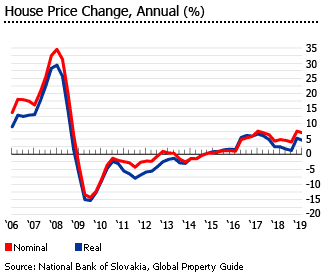
When adjusted for inflation, property prices rose by 4.53%. During the latest quarter, property prices increased 2.12% (0.79% in real terms).
Despite this, Slovakia’s house prices are still 3.6% below their Q2 2008 peak (-18% in real terms).
In Bratislava region, which has the country’s most expensive housing, residential property prices rose by 5.55% y-o-y to €2,053 (US$2,334) per sq. m. during the year to Q1 2019, after rising by 3.84% a year earlier.
All other regions also saw robust house price increases, except Kosice.
- Nitra experienced the biggest rise of about 27.06% y-o-y to €878 (US$998) per sq. m., a sharp improvement from the previous year’s 7.3% growth.
- In Trencin, house prices rose by 19.49% y-o-y to €895 (US$1,017) per sq. m., up from the prior year’s 6.4% increase.
- In Zilina, house prices increased 18.46% y-o-y to €1,046 (US$1,189) per sq. m. in Q1 2019, more than thrice the growth in the previous year.
- In Presov, house prices surged 17.71% y-o-y to €977 (US$1,111) per sq. m. – almost 6 times the growth in Q1 2018.
- In Trnava, house prices rose by 12.4% y-o-y to €1,124 (US$ 1,278) per sq. m., up from an increase of 9.7% in Q1 2018.
- In Banska Bystrica, house prices increased 5.55% y-o-y to €809 (US$920) per sq. m., a slowdown from a rise of 8.5% a year earlier.
- In Kosice, house prices fell by 3.54% y-o-y to €1,035 (US$1,177) per sq. m., in contrast to a 7.3% growth in a year earlier
The housing boom in Slovakia lasted from 2006 to Q2 2008. The surge stopped in late 2008, and in following years prices either fell or only increased a little.
HOUSE PRICES IN SLOVAK REPUBLIC, ANNUAL CHANGE (%) |
||
| Year | Nominal | Inflation-adjusted |
| 2009 | -12.31 | -12.66 |
| 2010 | -2.08 | -3.16 |
| 2011 | -2.68 | -6.86 |
| 2012 | 0.89 | -2.55 |
| 2013 | -2.57 | -3.01 |
| 2014 | 0.25 | 0.25 |
| 2015 | 1.15 | 1.62 |
| 2016 | 5.84 | 6.00 |
| 2017 | 4.29 | 2.43 |
| 2018 | 7.57 | 5.27 |
| Sources: National Bank of Slovakia, Global Property Guide | ||
House prices in Slovakia are expected to continue rising during the remainder of the year. Property demand, both from local and from foreign investors, is surging, according to local property experts.
That’s largely because Slovakia’s economy is projected to expand by a robust 3.8% this year, according to the European Commission. Slovakia registered economic growth of 4.1% in 2018, after GDP growth of 3.2% in 2017, 3.1% in 2016, 4.2% in 2015, and 2.8% in 2014. This strong economic growth is likely to continue boosting house prices in the coming years.
There are no legal restrictions on foreigners buying buildings in Slovakia.
AVERAGE RESIDENTIAL PROPERTY PRICES |
|||||
| House price boom (Q1 2005-Q4 2008) | Global financial crisis, eurozone debt crisis (Q1 2009-Q4 2015) | Economic growth (2016-18) | Q1 2019 (y-o-y change) | Euro/sq. m. (Q1 2019) | |
| SLOVAKIA | 78.19 | -12.81 | 18.75 | 7.02 | 1,494 |
| Bratislava | 70.69 | -6.13 | 17.48 | 5.55 | 2,053 |
| Trnava | 65.23 | -15.83 | 32.46 | 12.40 | 1,124 |
| Nitra | 111.08 | -29.40 | 51.97 | 27.06 | 878 |
| Trencin | 177.00 | -22.13 | 30.61 | 19.49 | 895 |
| Zilina | 122.97 | -17.13 | 32.00 | 18.46 | 1,046 |
| Banska Bystrica | 124.67 | -14.06 | 8.18 | 5.20 | 809 |
| Kosice | 118.11 | -3.44 | 12.84 | -3.54 | 1,035 |
| Presov | 77.76 | -22.15 | 23.01 | 17.71 | 977 |
| Sources: National Bank of Slovakia, Global Property Guide | |||||
Apartment prices are surging
Apartments registered the biggest house price gains nationally, rising by 8.4% y-o-y in Q1 2019 to an average price of €1,822 (US$2,071) per sq. m, according to the NBS.

- 1-room: prices soared 11.1% to €2,083 (US$2,368) per sq. m during the year to Q1 2019
- 2-room: prices rose by 9% to €1,932 (US$2,196) per sq. m during the year to Q1 2019
- 3-room: prices rose by 7.8% to €1,705 (US$1,938) per sq. m over the same period
- 4-room: prices increased 7.5% y-o-y to €1,743 (US$1,981) per sq. m in Q1 2019
- 5+-room: prices surged by 12.7% y-o-y to €1,804 (US$2,051) per sq. m in Q1 2019
Houses increased in value by 5.1% to €1,195 (US$1,359) per sq. m. during the year to Q1 2019.
Residential construction is rising strongly
In 2018, the number of housing starts stood at 22,055 units, up by 10.7% from a year earlier and the highest level since 2008, according to the Statistical Office of the Slovak Republic. Likewise, completions are now back at pre-crisis levels, and have risen by 12.5% to 19,071 units in 2018 – higher than the average yearly completions of 15,500 units from 2003 to 2009.
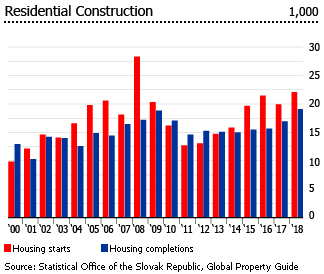
In Q1 2019:
- Dwelling permits increased 7.7% y-o-y to 3,860 units
- Dwelling starts rose by 8.2% y-o-y to 4,129 units
- Completions rose slightly by 0.2% y-o-y to 4,356 units
- Dwellings under construction increased 4.2% y-o-y to 77,402 units
Low interest rates are boosting property demand
The average interest rate on new housing loans stood at 1.49% in March 2019, having fallen continuously from 1.65% in March 2018, 1.88% in March 2017, 2.11% in March 2016, and 2.87% in March 2015, according to the NBS.
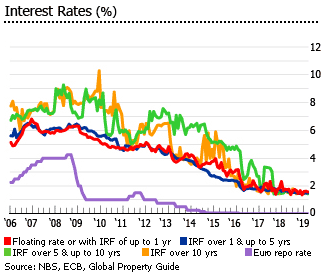
In March 2019:
- Average floating rate loan interest rate (or loans with interest rate fixation (IRF) of up to 1 year): 1.57%, down from 1.76% a year ago
- IRF over 1 to 5 years: 1.49%, down from 1.65% a year ago
- IRF over 5 to 10 years: 1.43%, down from 1.63% in the previous year
- IRF of over 10 years: 1.55%, down from 1.69% a year earlier
The low interest rate environment is due to the European Central Bank cutting its key rate to a historic low of 0.00% in March 2016, where it has remained since. Unsurprisingly in April 2019, the total outstanding amount of housing loans to households rose by almost 11% to €29 billion (US$33 billion) from the same period last year, according to the NBS.

The size of the mortgage market grew rapidly to about 31.3% of GDP in 2018, from 29.9% of GDP in 2017, 16.1% of GDP in 2010, and just 6.3% of GDP in 20o4.
Rental market is very limited
Bratislava appears to be an attractive location to own properties but anecdotally, properties can be quite hard to let. Bratislava is a small place, and few people absolutely need to live in the centre of town unlike the larger capitals of other countries where commuting times can be inconveniently high. Because Slovakia itself is small, the number of expatriates, embassies, and international companies in Bratislava is small, which again restricts the supply of tenants.
Owner-occupancy in Slovakia has risen sharply from about 50% during the 1980s to currently above 90%, making Slovakia the country with the third highest homeownership rate in the EU, way past the EU average of less than 70%. Tenants were only around 9.7% of Slovakia’s population, according to Eurostat.
But only 0.1% of Slovakia’s housing stock is let out by private landlords, mainly in Bratislava.
The growth of owner-occupation is partly due to contractual savings system (Bauspar) that makes it easy for Slovaks to obtain housing loans. This Bauspar system allows borrowers to take loans at lower interest rates, with the government paying an interest premium on the amount saved.
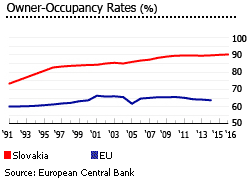
In 2005, the government decreed the abolition of rent control, effective July 1, 2007. However, the decree was never implemented. Rent deregulation has been postponed repeatedly, as Parliament refuses to deal with this highly sensitive issue.
Yields are moderately good; rents are still low
According to the Global Property Guide research conducted in September 2018, in Stare Mesto, Bratislava’s city centre:
- Gross rental yields on 40 sq. m. apartments were around 5.01%.
- Larger units of around 120 sq. m. had slightly lower yields of 4.53%.
- The average yield in Stare Mesto fell slightly to around 4.5% this year, from 5% in 2016 and 5.53% three years ago.
In the Bratislava’s less upscale districts of Ruzinov and Nove Mesto (Bratislava II and III), gross rental yields were not much different, between 4.6% to 5.7%. The Airbnb market is thriving, but expect damage to your property.
Rents range from around €11 (US$12.5) to €14 (US$16) per sq. m. per month in the Old Town of Bratislava, whereas in the nearby areas of Ruzinov and in the New Town, rents range from €9 (US$10.2) to €12.5 (US$14.2) per sq. m. per month.
Round trip transaction costs are very low on residential property in Slovakia.
Healthy economic growth; falling unemployment
Slovakia is one of Eastern Europe’s most successful transition countries. Born in 1993 after seceding amicably from the Czech Republic (the two countries were formerly known as Czechoslovakia), it has a stable polity and liberal market economy. Slovakia benefited from eight years’ reform under the centre-right coalition led by Mikulas Dzurinda (1998-2004) whose reforms won praise from international organizations, and who oversaw EU and Nato entry.
The economy’s rapid growth facilitated the country’s membership of the Organization for Economic Cooperation and Development (OECD) and the European Union (EU) in 2004. In December 2007 Slovakia became a full member of the Schengen Zone, allowing passport-free travel in the 24-member European nations.
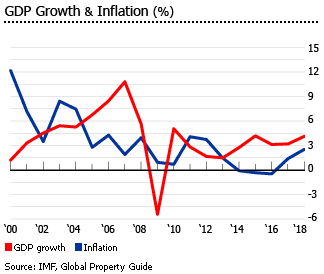
In 2006 Roberto Fico became Prime Minister (prime minister 2006-2010, and 2012 to March 2018), swept in on a victory for the populist Smer party after loudly criticizing the previous right-wing government’s economic, tax, social, pension and legislative reforms. These had been seen as very positive and successful by such international bodies as the IMF, the World Bank and OECD. However they negatively affected large segments of the population, particularly low wage earners, the unemployed, and welfare and other social assistance recipients. While in opposition, and primarily during the election campaign, Fico vowed to reverse the majority of these reforms, but on taking office he adopted a more cautious approach, and Slovakia successfully fulfilled the Maastricht criteria required for Euro currency adoption on 1 January 2009.
Fico conducted virulent campaigns insulting press critics as anti-Slovaks, who in turn produced many revelations of his corruption, including the unexplained wealth of an apparent mistress, his now-secretary Halászová. Fico’s stewardship was marked by tension with Hungary, and populism towards Slovakia’s Roma population and Muslim refugees.
Real GDP growth reached an impressive 10.8% in 2007, following 8.5% growth in 2006. Kia, Volkswagen, and Peugeot Citroen all have built large car plants in Slovakia. In 2008 there was 5.6% growth.
With the crisis there was a 5.4% GDP contraction in 2009. Slovakia’s economy recovered quickly with GDP growth of 5% in 2010, but this was followed by 4 weak years, with 2.8% GDP growth in 2011, 1.7% in 2012, 1.5% in 2013 and 2.8% in 2014.
In the past four years, the economy bounced back, recording a 4.2% expansion in 2015, 3.1% in 2016, 3.2% in 2017 and another 4.1% in 2018. The Slovakian economy is projected to expand by 3.8% this year and by another 3.4% in 2020, according to the European Commission.
Slovakia’s budget deficit fell to just 0.7% of GDP in 2018, down from 0.8% in 2017, 2.2% in 2016, 2.6% in 2015 and 2.7% in 2013 and 2014. The country is expected to record a deficit of 0.5% of GDP this year, based on projections by the European Commission.
Slovakia’s gross public debt has fallen to 48.9% of GDP in 2018, down from 50.9% in 2017 and 54.7% in 2013, according to the Statistical Office of the Slovak Republic, and is projected to fall further to 47.3% of GDP this year, and to 46% of GDP in 2020.
In May 2019, nationwide inflation stood at 2.7%, up from 2.4% in the previous month, according to the Statistical Office of the Slovak Republic. Inflation is expected at 2.4% this year, from 2.5% in 2018, 1.4% in 2017, -0.5% in 2016, -0.3% in 2015 and -0.1% in 2014.

Unemployment fell to a record low of 6.5% in 2018, from 8.1% in 2017, 9.7% in 2016 and from an annual average of 13.3% from 2009 to 2015, according to the IMF. The jobless rate is expected to fall further to 5.9% this year and to 5.6% in 2020.
Fico resigned the premiership in March 2018, following the murder of investigative journalist Ján Kuciak, who was writing stories on tax frauds and the connections of the Italian mafia ´Ndrangheta to Mária Trošková, an assistant to Fico. However the current ruling government coalition continues, Smer having named as prime minister former Deputy Prime Minister Peter Pellegrini. Fico remains the power behind the throne.
During the March 2019 presidential election, pro-EU opposition candidate Zuzana Caputova beats the government’s Maros Sevcovic, with 58% of the vote. Caputova’s socially-liberal and pro-EU stance will put her at loggerheads with the pro-Russian government when she takes office in June.
Sources:
- Residential property prices (National Bank of Slovakia): https://www.nbs.sk/en/statistics/selected-macroeconomics-indicators/residential-property-prices
- Construction (Statistical Office of the Slovak Republic): http://datacube.statistics.sk/#!/view/en/VBD_INTERN/st0003qs/Housing%20construction%20and%20decrease%20of%20dwellings%20%5Bst0003qs%5D
- World Economic Outlook Database (International Monetary Fund): https://www.imf.org/external/pubs/ft/weo/2019/01/weodata/index.aspx
- MFI aggregated balance sheet (European Central Bank): https://sdw.ecb.europa.eu/browse.do?node=9691311
- Financial markets and interest rates (European Central Bank): https://sdw.ecb.europa.eu/browse.do?node=9691099
- Rental returns are moderate in Bratislava, Slovakia (Global Property Guide): https://www.globalpropertyguide.com/Europe/Slovak-Republic/Rental-Yields
- NBS Monthly Bulletin – 2019 (National Bank of Slovakia): http://www.nbs.sk/en/publications-issued-by-the-nbs/nbs-monthly-bulletin/2019
- Economic forecast for Slovakia (European Commission): https://ec.europa.eu/info/business-economy-euro/economic-performance-and-forecasts/economic-performance-country/slovakia/economic-forecast-slovakia_en
- Europe´s border-free zone expands (BBC News): http://news.bbc.co.uk/2/hi/europe/7153490.stm
- Slovakia Government Budget (Trading Economics): https://tradingeconomics.com/slovakia/government-budget
- Slovakia profile – Timeline (BBC News): https://www.bbc.com/news/world-europe-17848213
- Slovakia country profile (BBC News): https://www.bbc.com/news/world-europe-17847682